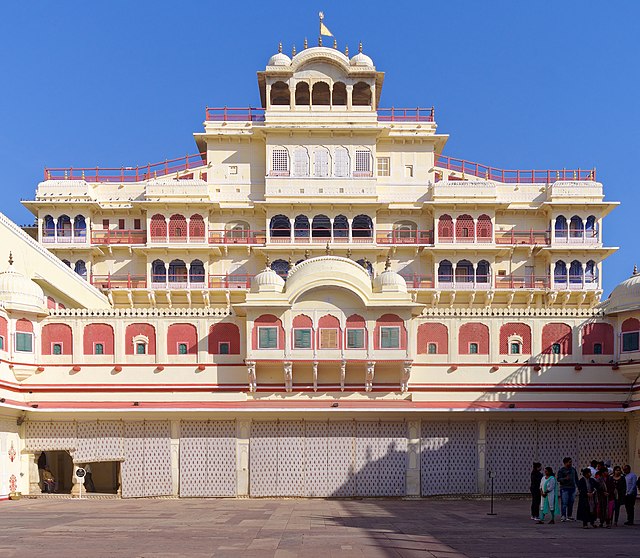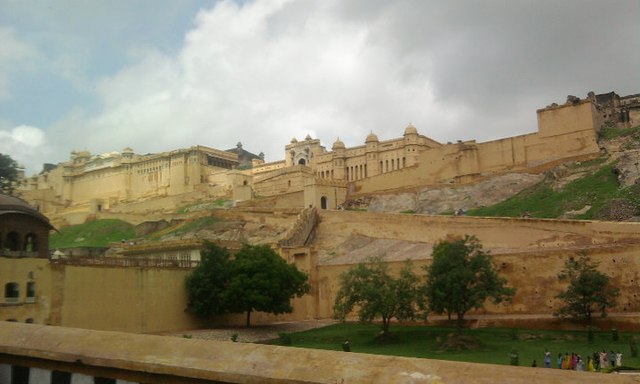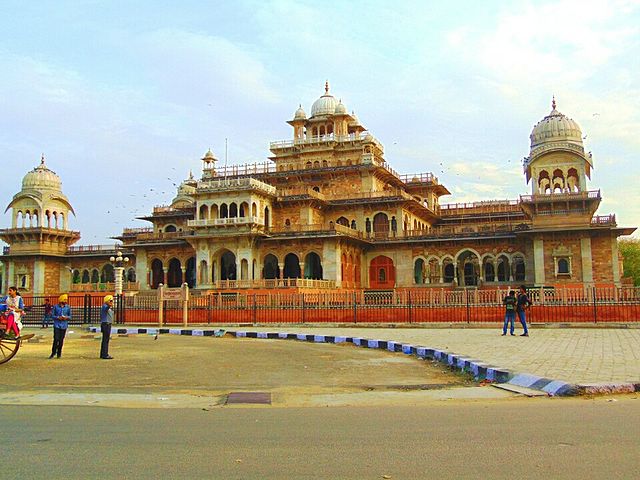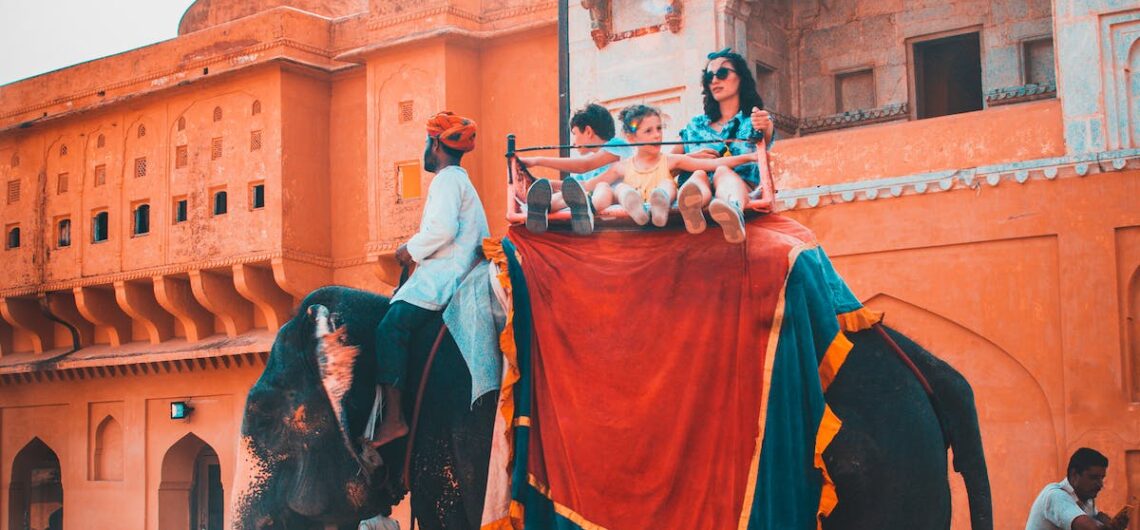Nestled in the heart of Rajasthan, Jaipur, famously known as the Pink City, is a tapestry of vibrant history, royal grandeur, and cultural richness. This city, founded by Maharaja Sawai Jai Singh II in 1727, boasts an array of architectural wonders, from the regal Amer Fort and opulent City Palace to the iconic Hawa Mahal. With its bustling markets, sumptuous cuisine, and a kaleidoscope of traditions, Jaipur is a captivating destination where the past seamlessly intertwines with the present.
Contents
Hawa Mahal
Hawa Mahal, or the “Palace of Winds,” stands as a poetic testimony to Jaipur’s rich history and architectural legacy. Built in 1799 by Maharaja Sawai Pratap Singh, this iconic structure was designed by Lal Chand Ustad.

The mahal, resembling the crown of Lord Krishna, served as an extension of the City Palace, allowing royal women to observe street festivals and daily life through its intricately designed windows without being seen. The unique five-story exterior, adorned with 953 small windows or “jharokhas,” reflects the fusion of Rajput and Mughal architectural styles.
Hawa Mahal continues to be a symbol of Jaipur’s royal past and architectural ingenuity, drawing visitors into the enchanting narrative of Rajasthan’s regal history.
City Palace
The City Palace in Jaipur is a living testament to the opulent history of Rajasthan’s royalty. Constructed by Maharaja Sawai Jai Singh II in the 18th century, the palace complex amalgamates Rajput, Mughal, and European architectural influences.

Its sprawling grounds house an array of palatial structures, including the Chandra Mahal and Mubarak Mahal. Visitors are transported through time as they explore ornate courtyards, intricately decorated halls, and museums showcasing royal artifacts.
The City Palace stands as a majestic tribute to Jaipur’s regal legacy and is a must-visit for those seeking a glimpse into the grandeur of Rajasthan’s past.
Amber Fort
Perched majestically on a hill in Amer, just outside Jaipur, the Amber Fort is a magnificent fortification that echoes the valor and grandeur of Rajasthan’s history. Constructed in the 16th century by Raja Man Singh I and later expanded by successive rulers, the fort is an architectural marvel blending Rajput and Mughal styles.

The fort’s imposing walls conceal a world of regal opulence. As visitors ascend the hill, they are greeted by the imposing Suraj Pol, the Sun Gate, which leads to the main courtyard. The Diwan-i-Am (Hall of Public Audience) and Diwan-i-Khas (Hall of Private Audience) exemplify intricate mirror work, ornate frescoes, and exquisite marble inlays.
The Amber Fort is not merely a historical monument; it is a living testament to the cultural fusion and architectural brilliance of Rajasthan’s vibrant past.
Jantar Mantar
Built by Maharaja Sawai Jai Singh II in the 18th century, Jantar Mantar, an astronomical observatory nestled in the heart of Jaipur, is an intriguing testament to the scientific prowess of Maharaja Sawai Jai Singh II. Constructed in the early 18th century, this UNESCO World Heritage site is one of five such observatories he built across northern India.

It is designed to study celestial bodies with remarkable precision, Jantar Mantar comprises 19 architectural instruments, each serving a specific astronomical purpose. The monumental Samrat Yantra, or Sundial, is the largest of its kind, measuring time with unparalleled accuracy. The Yantras, geometric structures aligned with the stars, enable precise measurements of celestial phenomena like eclipses and equinoxes.
Albert Hall Museum
Established in 1887, the Albert Hall Museum is the oldest museum in Rajasthan. The Albert Hall Museum, located in the heart of Jaipur, stands as an architectural gem and a treasure trove of art and history.

Constructed in 1876 during the reign of Maharaja Sawai Ram Singh II, it was designed by British architect Sir Samuel Swinton Jacob. Originally intended to be a public hall, it was named after Albert Edward, then the Prince of Wales.
This museum, also known as the Government Central Museum, is an exquisite example of Indo-Saracenic architecture, blending elements of Indian, Mughal, and European styles. Its distinctive domes, arches, and intricate detailing create a captivating facade.
Jal Mahal
Although not extensively historical, Jal Mahal, or the Water Palace, has historical roots dating back to the 18th century. The palace was used for royal duck shooting parties. Jal Mahal, the “Water Palace,” is an exquisite

architectural marvel nestled in the midst of Man Sagar Lake, just outside Jaipur. Built in the 18th century by Maharaja Sawai Pratap Singh, this picturesque palace stands as a serene testament to the grandeur of Rajasthan’s heritage.
Jal Mahal’s strategic location offers breathtaking views of the surrounding Aravalli Hills and the city of Jaipur. Its tranquil setting makes it a popular spot for visitors seeking respite from the bustling city life.
While the exterior of Jal Mahal is a study in architectural elegance, the interior remains mostly inaccessible to the public. The palace has undergone restoration efforts to preserve its historical significance and maintain its unique charm.
Rambagh Palace
Rambagh Palace, a jewel in Jaipur’s crown, is a resplendent testament to the royal heritage of Rajasthan. Originally built in 1835 as a royal residence, it was later converted into a luxurious hotel by the Taj Group. Nestled amidst 47 acres of lush gardens, this palatial abode has hosted Maharajas and dignitaries, preserving the regal aura of its storied past.

The architecture of Rambagh Palace seamlessly blends Rajput and Mughal styles, creating a palatial setting that exudes opulence. Intricately carved arches, grand courtyards, and majestic corridors reflect the architectural brilliance of the bygone era.
The palace’s suites, adorned with period furniture and adorned with traditional Rajasthani décor, offer a glimpse into the extravagant lifestyle of the erstwhile royalty. The Peacock Suite, named after the national bird of India, is a luxurious retreat with its own private terrace and stunning views of the gardens.


Comments